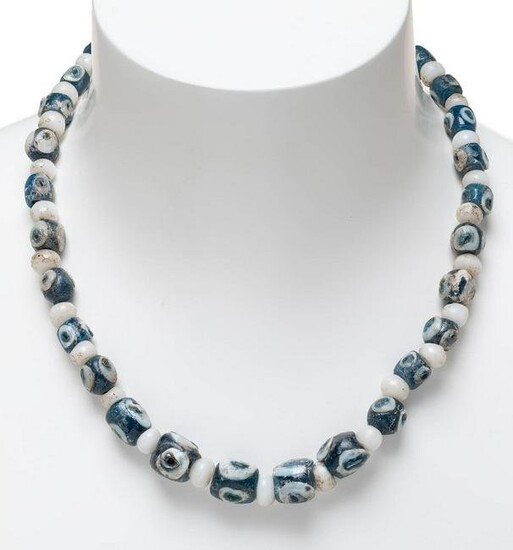A Phoenician necklace from the 4th century BC. Glass
A Phoenician necklace, 4th century BC.
Glass paste.
Provenance: public auction.
In good condition. Intact.
Measurements: 47 x 1.4 cm.
Phoenician necklace dated to the 4th century BC and made of vitreous paste with a bichrome tone (blue and white). Each bead has a combination of concentric hidden shapes that are reminiscent of a Turkish eye, used in the Anatolian area to ward off the evil eye. The core technique appeared in Mesopotamia around 1500 BC, and enjoyed its first flourishing in Egypt between 1500 and 1200 BC. A second flourishing will take place throughout the Mediterranean between the 6th and 1st centuries BC. It will be the most widely used technique until the discovery of blown glass in Roman times, when it will disappear definitively. It consists of preparing the mass by placing the different substances in a crucible, where they are heated until they melt together. It is then left to cool and the surface is scraped, using only the centre, which is where the glass is purest. This process is repeated several times until the glass paste is as pure as possible. A core is then formed in the approximate shape of the desired piece with a mixture of clay, dung and straw, and it is pricked on the end of a rod. This core is then covered with glass, either by dipping it into the crucible or, for better results, by covering it with hot glass cords wrapped around it. To smooth it, the piece was rolled on a flat surface.
Estimate
Time, Location
Auction House
A Phoenician necklace, 4th century BC.
Glass paste.
Provenance: public auction.
In good condition. Intact.
Measurements: 47 x 1.4 cm.
Phoenician necklace dated to the 4th century BC and made of vitreous paste with a bichrome tone (blue and white). Each bead has a combination of concentric hidden shapes that are reminiscent of a Turkish eye, used in the Anatolian area to ward off the evil eye. The core technique appeared in Mesopotamia around 1500 BC, and enjoyed its first flourishing in Egypt between 1500 and 1200 BC. A second flourishing will take place throughout the Mediterranean between the 6th and 1st centuries BC. It will be the most widely used technique until the discovery of blown glass in Roman times, when it will disappear definitively. It consists of preparing the mass by placing the different substances in a crucible, where they are heated until they melt together. It is then left to cool and the surface is scraped, using only the centre, which is where the glass is purest. This process is repeated several times until the glass paste is as pure as possible. A core is then formed in the approximate shape of the desired piece with a mixture of clay, dung and straw, and it is pricked on the end of a rod. This core is then covered with glass, either by dipping it into the crucible or, for better results, by covering it with hot glass cords wrapped around it. To smooth it, the piece was rolled on a flat surface.



